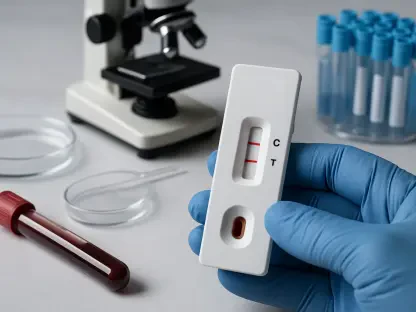Unveiling a New Era in Cardiac Care
In the rapidly advancing landscape of medical technology, artificial intelligence (AI) is carving out a transformative niche, particularly in the complex field of mitral valve repair. With millions of patients worldwide suffering from mitral regurgitation—a condition where the heart’s mitral valve fails to close properly, causing blood to flow backward—the demand for innovative, precise interventions has never been higher. This market analysis explores how AI is reshaping this critical segment of cardiac care, focusing on groundbreaking tools and partnerships that are setting new standards. By delving into current trends, competitive dynamics, and future projections, this examination aims to illuminate the strategic importance of AI adoption for stakeholders across the healthcare spectrum, from device manufacturers to clinical providers.
Market Dynamics: AI’s Role in Revolutionizing Mitral Valve Procedures
Cutting-Edge Visualization Tools Driving Growth
The integration of AI into mitral valve repair procedures is creating significant ripples in the medical device market, particularly through enhanced visualization technologies. A standout development is the collaboration between leading industry players to develop AI-powered solutions like DeviceGuide, which merges two-dimensional X-ray and ultrasound imaging into a dynamic 3D visual reference. This tool allows physicians to track the exact position of repair devices within a beating heart during transcatheter edge-to-edge repair (TEER), addressing longstanding challenges of navigation and precision. Market data suggests that such innovations are reducing procedure times by a notable margin, thereby increasing throughput in cardiac catheterization labs and driving demand for AI-enabled systems.
Competitive Landscape and Industry Partnerships
Beyond singular innovations, the market is witnessing a surge in strategic alliances aimed at embedding AI into cardiac interventions. Major corporations like Siemens Healthineers and GE HealthCare are forging partnerships with companies specializing in structural heart solutions and electrophysiology systems, reflecting a broader industry trend toward collaborative innovation. These alliances are not only accelerating the development of AI tools but also intensifying competition, as firms vie to establish dominance in this high-growth segment. The competitive pressure is fostering rapid advancements, with an increasing number of products entering limited releases in key markets like Europe, while awaiting regulatory approval in regions like the United States.
Adoption Challenges and Market Barriers
Despite the enthusiasm, the market faces hurdles in the widespread adoption of AI technologies for mitral valve repair. Regulatory scrutiny remains a significant barrier, with tools undergoing rigorous evaluation to ensure safety and efficacy before full-scale deployment. Additionally, regional disparities in healthcare infrastructure and reimbursement policies pose challenges to uniform market penetration. There is also a lingering concern among some clinicians about over-reliance on AI, fearing it might erode hands-on skills in complex procedures. Overcoming these obstacles will be crucial for market players to unlock the full potential of AI in this domain.
Future Projections: Scaling New Heights in Cardiac Interventions
Technological Advancements on the Horizon
Looking ahead, the market for AI in mitral valve repair is poised for exponential growth, driven by continuous technological refinements. Experts anticipate that by 2027, AI platforms could evolve to incorporate predictive analytics, using patient-specific data to forecast procedural outcomes and tailor interventions. Such advancements would further personalize care, enhancing success rates and reducing complications. The integration of machine learning algorithms with real-time imaging is expected to become a standard feature in cath lab workflows, signaling a shift toward fully AI-augmented surgical environments.
Economic and Accessibility Impacts
The economic implications of AI adoption in this field are equally compelling, with shorter procedure times translating into cost savings for hospitals and payers. This efficiency gain is likely to spur demand, particularly in emerging markets where access to specialized cardiac care remains limited. Projections indicate that AI tools could democratize expertise by lowering the learning curve for clinicians, enabling a broader pool of healthcare providers to perform complex repairs. This trend aligns with global health goals of improving access to advanced treatments, potentially reshaping market demographics over the next few years.
Regulatory Evolution and Market Expansion
Regulatory landscapes are also expected to adapt, with agencies likely to streamline approval processes for AI-driven medical tools as evidence of their efficacy mounts. This shift could accelerate market expansion, especially in high-demand regions. However, balancing innovation with patient safety will remain a focal point, requiring manufacturers to invest in robust clinical trials and transparent validation processes. As these frameworks evolve, the market is anticipated to see a surge in product launches, further intensifying competition and driving down costs through economies of scale.
Strategic Reflections and Forward-Looking Insights
Reflecting on the trajectory of AI in mitral valve repair, the market analysis underscores a pivotal shift toward precision and efficiency that has redefined clinical standards. The competitive fervor among industry giants has catalyzed remarkable innovations, while economic and accessibility benefits point to a more inclusive future for cardiac care. For stakeholders, the path forward involves strategic investments in partnerships and training programs to maximize the utility of AI tools. Manufacturers must prioritize navigating regulatory complexities to ensure swift market entry, while healthcare providers need to advocate for infrastructure upgrades to support these technologies. Ultimately, the journey of AI in this field highlights a transformative era that demands adaptability and foresight to fully realize its life-saving potential.









